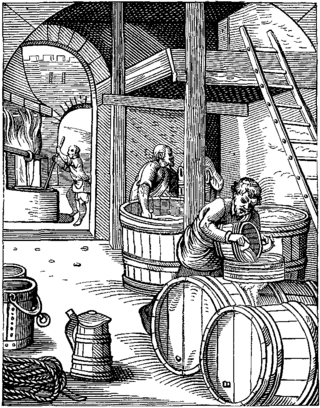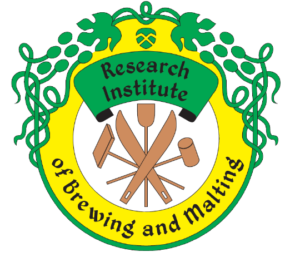Related Research Articles

Beer is one of the oldest alcoholic drinks in the world, the most widely consumed, and the third most popular drink after water and tea. Beer is produced by the brewing and fermentation of starches from cereal grains—most commonly malted barley, although wheat, maize (corn), rice, and oats are also used. The fermentation of the starch sugars in the wort produces ethanol and carbonation in the beer. Most modern beer is brewed with hops, which add bitterness and other flavours and act as a natural preservative and stabilising agent. Other flavouring agents, such as gruit, herbs, or fruits, may be included or used instead of hops. In commercial brewing, natural carbonation is often replaced with forced carbonation.

Brewing is the production of beer by steeping a starch source in water and fermenting the resulting sweet liquid with yeast. It may be done in a brewery by a commercial brewer, at home by a homebrewer, or communally. Brewing has taken place since around the 6th millennium BC, and archaeological evidence suggests that emerging civilizations, including ancient Egypt, China, and Mesopotamia, brewed beer. Since the nineteenth century the brewing industry has been part of most western economies.

Baker's yeast is the common name for the strains of yeast commonly used in baking bread and other bakery products, serving as a leavening agent which causes the bread to rise by converting the fermentable sugars present in the dough into carbon dioxide and ethanol. Baker's yeast is of the species Saccharomyces cerevisiae, and is the same species as the kind commonly used in alcoholic fermentation, which is called brewer's yeast or the deactivated form nutritional yeast. Baker's yeast is also a single-cell microorganism found on and around the human body.
Biotechnology and Biological Sciences Research Council (BBSRC), part of UK Research and Innovation, is a non-departmental public body (NDPB), and is the largest UK public funder of non-medical bioscience. It predominantly funds scientific research institutes and university research departments in the UK.

Brettanomyces is a non-spore forming genus of yeast in the family Saccharomycetaceae, and is often colloquially referred to as "Brett". The genus name Dekkera is used interchangeably with Brettanomyces, as it describes the teleomorph or spore forming form of the yeast, but is considered deprecated under the one fungus, one name change. The cellular morphology of the yeast can vary from ovoid to long "sausage" shaped cells. The yeast is acidogenic, and when grown on glucose rich media under aerobic conditions, produces large amounts of acetic acid. Brettanomyces is important to both the brewing and wine industries due to the sensory compounds it produces.
Zymase is an obsolete term for an enzyme complex that catalyzes the fermentation of sugar into ethanol and carbon dioxide. It occurs naturally in yeasts. Zymase activity varies among yeast strains.
The Budapest Treaty on the International Recognition of the Deposit of Microorganisms for the Purposes of Patent Procedure, or Budapest Treaty, is an international treaty signed in Budapest, Hungary, on April 28, 1977. It entered into force on August 19, 1980, and was later amended on September 26, 1980. The treaty is administered by the World Intellectual Property Organization (WIPO).

Worthington Brewery, also known as Worthington & Co. and Worthington's, is a British brewer founded by William Worthington in Burton upon Trent in 1761. It is the third oldest continuously brewed British beer brand, after Shepherde Neame and Whitbread. The best known Worthington beers are its Creamflow nitrokeg bitter and White Shield India Pale Ale.
The Energy Biosciences Institute (EBI) is an organization dedicated to developing new sources of energy and reducing the impact of energy consumption. It was created in 2007 to apply advanced knowledge of biology to the challenges of responsible, sustainable energy production and use. Its main goal is to develop next-generation biofuels—that is, biofuels that are made from the non-edible parts of plants and reduce greenhouse gas emissions.
The Brewing Industry Research Foundation is now part of Campden BRI, a research association serving all sectors of the food and drink industry. The Brewing Division is based next to the M23, and the other Divisions are located in Chipping Campden, Gloucestershire, where about 330 people are employed.

The Leibniz Institute DSMZ - German Collection of Microorganisms and Cell Cultures GmbH, located in Braunschweig, is a research infrastructure in the Leibniz Association. Also the DSMZ is the world's most diverse collection of bioresources. These include microorganisms as well as more than 840 human and animal cell cultures, over 1,500 plant viruses, over 940 bacteriophages, and 250 plasmids. Since 2010, the scientific director of the Leibniz Institute DSMZ has been Jörg Overmann, a microbiologist with a PhD from the University of Konstanz. He holds a professorship in microbiology at the Technical University of Braunschweig. Since August 2018, he has led the institute with leadership with Bettina Fischer as administrative director.

The Belgian Co-ordinated Collections of Micro-organisms (BCCM) is a Belgian government funded consortium of seven scientific institutions, who manage and exploit a collection of microbial and genetic resources. The consortium comprises more than 269,000 publicly available strains of bacteria including mycobacteria and cyanobacteria, filamentous fungi, yeasts, diatoms and plasmids.
Brettanomyces claussenii is a wild yeast of the genus Brettanomyces which has a negative Pasteur effect. It and Brettanomyces anomalus share identical mtDNA. In the wild, it is found on the skins of fruit. It has been shown to be useful for wine and beer fermentation as well as ethanol production.

Norwich Research Park (NRP) is a business community located to the southwest of Norwich in East Anglia close to the A11 and the A47 roads. Set in a 568-acre (230-hectare) area of parkland, it is one of five Biotechnology and Biological Sciences Research Council (BBSRC) funded Research and Innovation Campuses. It is the only site with three BBSRC funded research institutes and is considered as having one of Europe's largest concentrations of researchers in the fields of agriculture, genomics, health and the environment.
Symbiotic fermentation is a form of fermentation in which multiple organisms interact in symbiosis in order to produce the desired product. For example, a yeast may produce ethanol, which is then consumed by an acetic acid bacterium. Described early on as the fermentation of sugars following saccharification in a mixed fermentation process.

Ernest Stanley Salmon was a British mycologist and plant pathologist best known for his work in breeding new varieties of hops. Salmon crossed a wild Manitoban hop with cultivated English stock to create hybrid C9a, which was released to commercial cultivation in 1934 as Brewer's Gold. Though the original wild hop died during the winter of 1918–19, Brewer's Gold has become the ancestor of nearly every new high-alpha hop variety released since then.

The chemical compounds in beer give it a distinctive taste, smell and appearance. The majority of compounds in beer come from the metabolic activities of plants and yeast and so are covered by the fields of biochemistry and organic chemistry. The main exception is that beer contains over 90% water and the mineral ions in the water (hardness) can have a significant effect upon the taste.

The Quadram Institute is a centre for food and health research, combining Quadram Institute Bioscience, the Norfolk and Norwich University Hospitals' endoscopy centre and aspects of the University of East Anglia's Norwich Medical School and the Faculty of Science. It is located on the outskirts of Norwich, England, United Kingdom and is a member of the Norwich Research Park.

The Research Institute of Brewing and Malting (RIBM) in Czech - was founded in 1887 and since 1994 It has been a joint-stock company. It is one of the oldest scientific research institutes in the Central European region.

Kveik is a collective term for a family of strains of brewing yeast that has been used in Norwegian farmhouse brewing for generations.
References
- ↑ https://www.wipo.int/treaties/en/notifications/budapest/treaty_budapest_258.html, Budapest Notification No. 258 Budapest Treaty on the International Recognition of the Deposit of Microorganisms for the Purposes of Patent Procedure.
- ↑ https://web.archive.org/web/20080828085658/http://www.westerhambrewery.co.uk/News0205.htm, Westerham Brewing Co, archived from the original link on 28 August 2008. Retrieved 9 February 2010. .
- ↑ Kirsop, Barbara (1954). "The National Collection of Yeast Cultures". Journal of the Institute of Brewing. 60 (3): 210–213. doi:10.1002/j.2050-0416.1954.tb06225.x.
- ↑ Johnston, J. R. (1965). "Breeding Yeasts for Brewing". Journal of the Institute of Brewing. 71 (2): 130–135. doi:10.1002/j.2050-0416.1965.tb02035.x.
- ↑ https://www.ifst.org/eastern-branch-event-reviews-0, VISIT TO NATIONAL COLLECTION OF YEAST CULTURES - 28 FEBRUARY 2017.
- ↑ http://www.ukncc.co.uk/html/Information/NCYC%20Profile.htm, NCYC Research Profile.
- ↑ https://issuu.com/proactivepublications/docs/national_yeast, Proactive publications NCYC.
- ↑ https://www.eadt.co.uk/news/23083971.uk-brewers-store-yeast-strains-norwich-research-park/, UK brewers store yeast strains at Norwich Research Park.